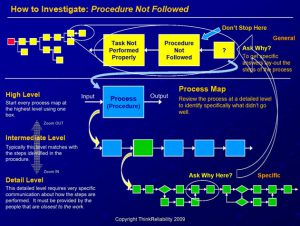Digging Deeper to Go Beyond Procedure Not Followed
Key Points for Effective Root Cause Problem Analysis
- Have as much detail compiled before discussion with front line personnel.
- Keep the forum informal. Avoid calling everyone up to the front office. Go to them.
- Consider using post-it notes with the front line personnel.
- Encourages them to write out steps.
- Encourage the smaller group to re-arrange the process step.
- Discuss how the process should work, and then discuss the specific steps that did not go well.
Nobody's perfect. Everybody makes mistakes.
These clichés, drilled into us since childhood to carry us through this fumbled football or that lost baseball game, ground us. They boost confidence, help us get off the mat and try, try again. We often observe the double standard: Learn from your mistakes, but by gosh dont make them at this company. Our society teaches us to value mistakes and learn from them to get better. But making the same mistake multiple times can try a bosss patience, depending on the organizations culture.
This isn't true for every organization, of course. Many Japanese companies and other organizations have embraced the philosophies of Edward Deming, the man behind the DMAIC (define, measure, analyze, inspect, control) methodology, as well as other progressive management and quality programs. But not all organizations are like this. Within some, managers are notified of a problem and, almost by default, jump into a "who did it" investigation.
High-performance organizations start a root cause analysis, map out the process, and then delve into a Cause Map. A Cause Map starts with the impacted goals on the left, and uses boxes to the right to describe the system of causes that led up to the event, as shown:

When someone discovers that an action deviates from the established procedure, he jots in the Cause Map, "Task Not Performed Properly." Why? He jots the following in the box to the right: Procedure Not Followed.

This tells nothing except that, well, someone didn't follow the procedure. If the people investigating the incident stop here, they're basically just finger-pointing, not finding a solution. At the same time, they put the procedure on a pedestal. The procedure is flawless. The people who dont follow it just aren't listening, don't care, or have it out for the organization, right?
Probably not. Holding a procedure blameless defies logic. Humans are imperfect; humans develop procedures; so it stands to reason that procedures are just as flawed as their human authors.
